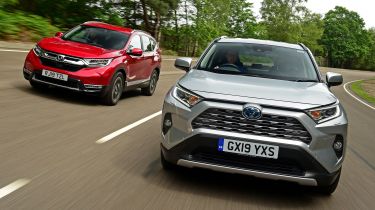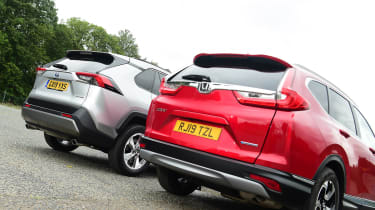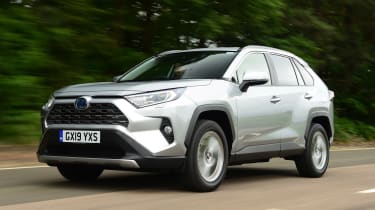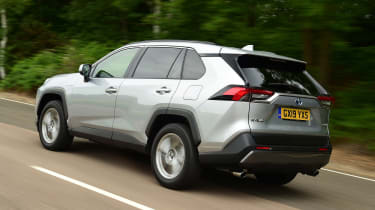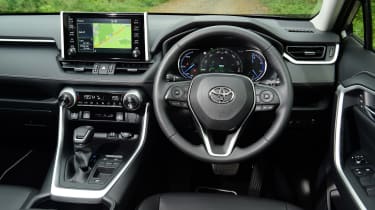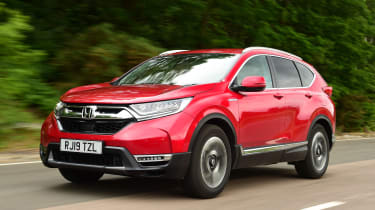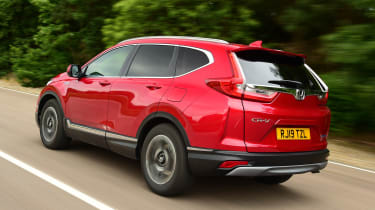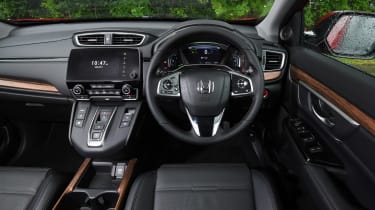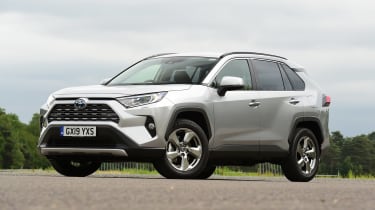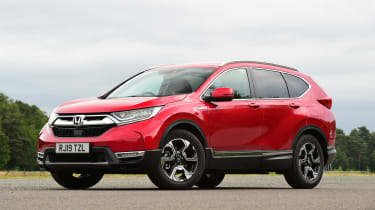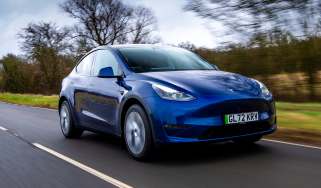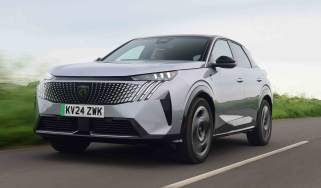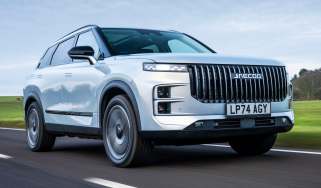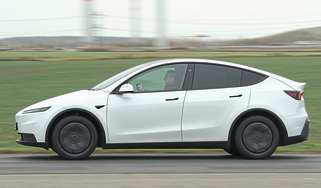Toyota RAV4 vs Honda CR-V
Hybrid powertrains are a popular electrification choice, so we’re testing the new Toyota RAV4 and Honda CR-V SUVs that use the technology
Despite the world looking for ways to deal with the imminent threat of catastrophic climate change, more and more buyers are choosing SUVs as their family cars. These models emit more CO2 and use more fuel than a smaller hatchback equivalent, because they’re generally larger and heavier.
While high-end manufacturers such as Jaguar and Audi are launching pure-electric SUV models, those cars will be out of most buyers’ price range.
Here are two brand new models that are much more affordable, and yet both offer the benefits of electrification with hybrid powertrains: the Toyota RAV4 Hybrid and the Honda CR-V Hybrid.
These are conventional hybrid models, so the batteries are charged using the engine (as well as through regenerative braking), rather than being plugged in. That means they’re more likely to fit into your life without the need for a driveway to top up at home, or a workplace car park with a charger. You simply fill up at a fuel station as with any other petrol vehicle.
This is the first time that we’ve tested either of these newcomers, so we’ll find out which SUV offers the best combination of running costs, practicality and comfort. The winner here will need to offer all of those things to work with family life, plus offer the level of standard equipment and in-car technology buyers demand.
Toyota RAV4
| Model: | Toyota RAV4 2.5 Hybrid 2WD Excel |
| Price: | £33,915 |
| Engine: | 2.5-litre 4cyl petrol plus electric motor, 215bhp |
| 0-60mph: | 7.8 seconds |
| Test economy: | 47.3mpg/10.4mpl |
| CO2: | 105g/km |
| Annual road tax: | £135 |
Toyota’s RAV4 has been around since 1994, but that version used combustion engines only. Later models had both ICE and hybrid powertrains, but this new edition is hybrid only. In front-wheel-drive Excel form, as tested here, it costs from £33,915.
Design & engineering
Toyota and Honda measure the output of their powertrains differently. The former publishes a total output (here it’s 215bhp), while the latter lists separate figures for the engine and electric motor (143bhp and 181bhp respectively in the CR-V). However, it’s not as simple as adding the Honda’s numbers together to compare the cars. For example, the RAV4’s combustion engine develops 176bhp and its motor produces 118bhp, yet the quoted total output is 215bhp.
Used - available now
It uses a 2.5-litre four-cylinder engine with its electric motor and, like all other Toyota hybrids, it sends power to the wheels via a CVT automatic transmission (which doesn’t have gears as such, and instead moves between ratios continuously). That’s slightly different to the Honda’s system, which mainly uses the electric motor for power, with occasional help from the engine.
The RAV4 sits on the Toyota New Global Architecture (TNGA) platform, a set-up designed to integrate electrification at its core, alongside improvements to body rigidity and lightness. It’s also used to build the Japanese firm’s C-HR, Corolla and Prius models, and here it features MacPherson struts at the front and double wishbones at the rear.
Interior build quality is good, and leather seats come as standard, but there are still a few cheap-looking materials around the cabin. The display screen, aside from being a bit of a pain to use , looks a bit awkward on top of the dash. Still, the cabin is quite similar to the Honda’s in terms of build and material quality.Both models are very well equipped, too, with the RAV4 featuring adaptive cruise control, heated leather seats, LED lights, a powered tailgate and satellite navigation among its list of standard kit.
Driving
Toyota’s RAV4 follows a similar recipe to the marque’s other hybrid models, so it’s no surprise that it drives similarly to other models based on the TNGA platform. The electric motor means that driving around town is relaxing, because the car relies on battery power at low speed. It’s almost silent in traffic, and the engine only kicks in when you pick up the pace. The 2.5-litre petrol isn’t as hushed as the 1.8-litre unit in the Corolla and Prius models, but its noise is kept to the background for the most part, just like the engine in the CR-V.
If you require faster acceleration and put your foot down, the CVT gearbox sends the revs soaring to maximise power, and it’s here that the engine becomes a bit noisy and unpleasant. Yet the RAV4 is more responsive than the Honda in this situation, and the revs quickly drop as you get up to speed.
The Toyota was a little slower from 0-60mph in our tests than its rival, taking 7.8 seconds to the Honda’s 7.5 seconds, but both SUVs went from 30-70mph in 6.8 seconds. This replicates a more common everyday driving situation, and it shows how evenly matched these two cars are. They also both accelerated from 30-50mph and 50-70mph within 0.2 seconds of each other, so there’s no noticeable advantage in performance.
It’s a similar story when it comes to ride comfort and handling, because the Toyota and Honda are pretty evenly matched in this area. The CR-V is a little bit more comfortable over rough roads, but the RAV4 is slightly more settled at speed. The main reason to choose the RAV4 over the CR-V behind the wheel is because its driving position is more comfortable; neither model is a driver’s car, because these heavy cars roll into corners and have numb steering.
Practicality
Bilky batteries usually mean hybrids are less practical than their combustion-engined counterparts, but these two big SUVs still have plenty of space in the back. The boxy Toyota has the edge here, with 580 litres in its boot. That’s over 80 litres more than the CR-V’s 497 litres.
There’s more than enough leg and headroom in the back for even tall adults to sit comfortably, because the Toyota’s rear seatbacks are quite reclined. Few people will complain about the space inside, though, and while the cubbies in the RAV4 are a little smaller than the Honda’s, there’s still plenty of space to store anything and everything a family might need.
Ownership
Both models are exceptionally well equipped for safety kit, with AEB, lane-keep assist, blind-spot warning, reversing cameras, adaptive cruise control and parking sensors fitted as standard. The Toyota has one extra airbag, which helped it to score slightly higher in its Euro NCAP crash test, although both cars were awarded five stars for safety overall.
Toyota’s five-year, 100,000-mile warranty is among the best of any car manufacturer and beats the three-year cover on its rival, although Honda offers an extra 24 months of breakdown cover.
Running costs
Hybrids are great for company car drivers due to their low CO2 emissions, which translate to lower tax bills. The RAV4’s 105g/km figure puts it in the 25 per cent Benefit-in-Kind (BiK) bracket, so higher-rate earners will pay £3,372 a year in tax. The CR-V’s higher emissions of 120g/km put it in the 28 per cent BiK category, so the tax contribution rises to £3,792.
Testers’ notes: “There are four-wheel-drive versions of both cars available, but we’d stick to the front-wheel-drive models that we tested, because they’re cheaper to buy and run than their AWD siblings.”
Honda CR-V
| Model: | Honda CR-V Hybrid 2WD eCVT SR |
| Price: | £34,070 |
| Engine: | 2.0-litre 4cyl petrol plus electric motor, N/A |
| 0-60mph: | 7.5 seconds |
| Test economy: | 45.4mpg/10.0mpl |
| CO2: | 120g/km |
| Annual road tax: | £135 |
The Honda CR-V is also available with a 1.5-litre petrol engine, unlike its hybrid-only rival here. We’re testing a Hybrid 2WD model in SR specification, which costs from £34,070, making it slightly more expensive than the Toyota.
Design & engineering
Honda’s hybrid powertrain is slightly different to Toyota’s, because while the RAV4’s engine regularly powers the wheels directly in combination with the electric motor, the CR-V’s 2.0-litre petrol unit is mostly used to keep the battery topped up.
That means the electric motor does most of the work when you’re driving. This still isn’t a range-extender hybrid, though, because there’s a unique single-speed gearbox fitted that can engage the engine to drive the wheels when extra poweris needed to accelerate quickly. Honda calls it eCVT, but it’s not the same as the Toyota’s CVT, despite the end result being similar: both are automatic transmissions without traditional gears.
The duo can drive in fully electric mode, but the Honda’s small battery limits this to just one mile of range, although the EV Mode in the RAV4 won’t manage much further before the engine kicks in.
Honda uses MacPherson struts at the front and a multi-link set-up at the CR-V’s rear, and although it’s relatively heavy, at 1,614kg, the Toyota’s kerbweight is only slightly less, at 1,590kg.
Interior fit and finish are about on par with the RAV4’s, with both models having leather upholstery and a mix of soft and hard plastics. The dashboard design is also quite similar, although our CR-V was fitted with artificial wood trim that looks a bit tacky.
Standard equipment is pretty much identical as well. Both SUVs come with everything you really need, including sat-nav, adaptive cruise, blind-spot assist, AEB, LED lights and heated seats. However, the Honda doesn’t have a powered tailgate in SR trim, because that’s limited to higher-spec EX models.
Driving
The Honda’s relatively high kerbweight and tall stance mean it’s not much fun to drive, like the Toyota. Its body rolls significantly in corners, and there’s no feel or feedback from the steering. That won’t matter to the vast majority of buyers, though, and the RAV4 isn’t much better in this respect.
Another thing the cars have in common is a spongy brake pedal with an unpleasant feel. The regenerative braking systems help to boost efficiency by topping up the battery every time you slow down, but it does take a toll on pedal feel.
What really matters is comfort, however, and the Honda does a lot better in that regard. It rides smoothly over rough tarmac, and while its body roll is a bit disconcerting in corners, the CR-V is comfortable enough if you keep things relaxed.
With the electric motor driving the wheels most of the time, the engine is hushed and kept at low revs, so it’s quieter than the 2.5-litre engine in the Toyota. However, put your foot down and a clutch engages the engine, sending revs up and refinement down. When accelerating, the engine sounds a bit less strained than the Toyota’s, but it’s louder in the cabin. Yet the Honda is a little quicker than its rival, because it was faster in our 0-60mph acceleration test, as well as from 30-50mph, where it took 2.6 seconds, compared with the RAV4’s 2.8 seconds.
Both cars are quiet on the motorway, and we recorded identical figures in our noise tests at 30mph and 70mph. There really isn’t much to split these two when it comes to the driving experience.
Practicality
The Honda’s boot is a bit smaller with the rear seats up, at 497 litres to the Toyota’s 580 litres. However, fold the rear seats down and this opens out to 1,697 litres, which is seven litres more than the RAV4 offers in the same configuration. Either way, both of these models are very spacious for luggage, especially considering they’re carrying batteries as well as engines.
The back seats in the CR-V are a little less roomy than the Toyota’s, but legroom is still more than good enough for tall adults, and headroom is fine as well; both models are very spacious in the rear.
Up front, the Honda features a huge central cubby and plenty of other storage spaces around the cabin, which are useful for stowing odds and ends.
Ownership
Honda finished seventh overall in the manufacturer’s chart of our Driver Power 2019 satisfaction survey, which is a strong result, and puts it three places above Toyota.
Honda’s dealers fared even better, coming a very impressive second in our 2018 poll, while Toyota’s were just behind, in third position.
Euro NCAP rated these cars five stars out of five when they were crash-tested this year, and it’s no surprise when you look at the standard safety kit. The CR-V and RAV4 both feature autonomous emergency braking, blind-spot assist, lane-keep assist and adaptive cruise as standard.
Running costs
Honda’s SUV returned fuel economy of 45.4mpg on test, which was worse than the Toyota’s 47.3mpg. It means the CR-V will cost owners £1,545 a year at the pumps, while the RAV4 will set you back £1,483 for petrol.
The CR-V’s estimated residual value is very good, though, at 49.3 per cent after three years. It will lose £17,273 after this period and be worth £16,797. This is a big saving over the Toyota, which has a predicted residual value of 40.9 per cent. That means it will shed £20,044 after 36 months and be worth £13,871.
Testers’ notes: “Avoid a hybrid SUV if you are planning to tow a caravan or trailer. The Honda can only pull a maximum of 750kg, and the RAV4 isn’t much better, at 800kg.”
Verdict
First place: Toyota RAV4
The RAV4 Hybrid wins here because it’s more practical and more efficient than its rival – two of the most important aspects for buyers in this market. The Toyota is cheaper to buy and marginally better to drive, although there’s not too much between them on the road. It’s well equipped, too, with plenty of protective systems, and a good choice if you’re set on a hybrid SUV as your next family car.
Second place: Honda CR-V
Despite falling behind here, the CR-V Hybrid is still very much a valid choice, because it’s quiet, comfortable and cheap to run. Plus, despite not being as spacious as the RAV4, it still offers plenty of practicality. Its infotainment system is a little better than the Toyota’s, because it has Apple CarPlay and Android Auto, but both models have a very similar amount of standard kit and safety technology.
Other options in this category...
SEAT Tarraco
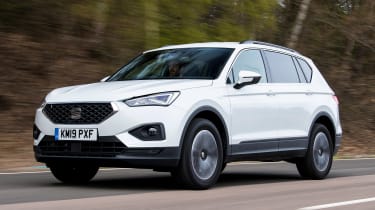
Model: SEAT Tarraco SE Technology 2.0 TDI DSGPrice: £34,010Engine: 2.0-litre 4cyl, 148bhp
The SEAT Tarraco is our favourite big SUV, and it’s even more practical than the RAV4, thanks to its huge 700-litre boot or two extra seats in the back. While diesel power isn’t as popular as it once was, the Tarraco still offers strongfuel economy and solid pace.
Mitsubishi Outlander PHEV
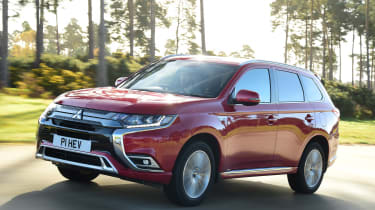
Model: Mitsubishi Outlander PHEV JuroPrice: £36,755Engine: 2.4-litre 4cyl & e-motor
It may be more pricey than its rivals here, but a Mitsubishi Outlander plug-in hybrid could make even more sense if you have a driveway. You can charge the battery at home and only use electric power for short trips, possibly makingfor super-cheap motoring.
Figures
| Toyota RAV4 2.5 Hybrid 2WD Excel | Honda CR-V Hybrid 2WD eCVT SR | |
| On the road price/total as tested | £33,915/£34,160 | £34,070/£35,320 |
| Residual value (after 3yrs/36,000) | £13,871/40.9% | £16,797/49.3% |
| Depreciation | £20,044 | £17,273 |
| Annual tax liability std/higher rate | £1,671/£3,342 | £1,896/£3,792 |
| Annual fuel cost (12k/20k miles) | £1,686/£3,372 | £1,545/£2,575 |
| Insurance group/quote/road tax cost | 25/£610/£135 | 24/£502/£135 |
| Cost of 1st, 2nd and 3rd service | £190/£340/£190 | £895 (5 years) |
| Length/wheelbase | 4,600/2,690mm | 4,603/2,663mm |
| Height/width | 1,685/1,855 mm | 1,689/1,855mm |
| Engine | 4cyl in-line/2,487cc | 4cyl in-line/1,993cc |
| Peak power/revs | 215/N/A bhp/rpm | 143/6,200 bhp/rpm* |
| Peak torque/revs | 221/3,600 Nm/rpm | 175/4,000 Nm/rpm* |
| Transmission | CVT auto/fwd | eCVT auto/fwd |
| Fuel tank capacity/spare wheel | 55 litres/full-size | 57 litres/repair kit |
| Boot capacity (seats up/down) | 580/1,690 litres | 497/1,697 litres |
| Kerbweight/payload/towing weight | 1,590/545/800kg | 1,614/626/750kg |
| Turning circle | 11.0 metres | 11.4 metres |
| Basic warranty (miles)/recovery | 5yrs (100,000)/1yr | 3yrs (90,000)/3yrs |
| Driver Power manufacturer/dealer pos. | 10th/3rd^ | 7th/2nd^ |
| NCAP: Adult/child/ped./assist/stars | 93/87/85/77/5 | 93/83/70/76/5 |
| 0-60/30-70mph | 7.8/6.8 secs | 7.5/6.8 secs |
| 30-50mph | 2.8 secs | 2.6 secs |
| 50-70mph | 4.1 secs | 4.2 secs |
| Top speed/rpm at 70mph | 111mph/N/A | 112mph/N/A |
| Braking 70-0/60-0/30-0mph | 55.5/37.7/10.4m | 49.5/34.3/10.1m |
| Noise outside/idle/30/70mph | N/A/42/63/72dB | N/A/43/63/72dB |
| Auto Express econ. (mpg/mpl)/range | 47.3/10.4/572 miles | 45.4/10.0/569 miles |
| WLTP combined mpg | 48.7-50.4mpg | 40.9mpg |
| WLTP combined mpl | 10.7-11.1mpl | 9.0mpl |
| Actual/claimed CO2/tax bracket | 138/105g/km/25% | 144/120g/km/28% |
| Airbags/Isofix/park sensors/camera | Seven/yes/yes/yes | Six/yes/yes/yes |
| Auto box/lane-keep/blind spot/AEB | Yes/yes/yes/yes | Yes/yes/yes/yes |
| Clim./cruise ctrl/leather/heated seats | Yes/adaptive/yes/yes | Yes/adaptive/yes/yes |
| Met paint/LEDs/keyless/pwr tailgate | £545/yes/yes/yes | £550/yes/yes/no |
| Nav/digi dash/DAB/connected apps | Yes/yes/yes/yes | Yes/yes/yes/yes |
| Wireless charge/CarPlay/Android Auto | No/no/no | No/yes/yes |
